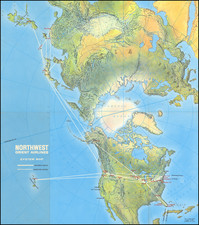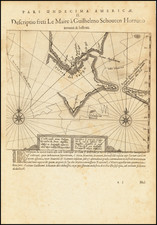An Unrecorded Late Edition of John Melish's World Map. Showing the Earliest Transatlantic Cable and Exploration of the Arctic and the Antarctic Coast.
A large engraved world map, published by L. Stebbins in 1859, using the same plate as John Melish's 1817 The World on Mercator's Projection.
Melish's World Map
John Melish, who is best known for his hugely important map of the United States, was also responsible for a large world map published in 1817. See the Library of Congress copy of the Melish world map. We have been unable to identify any recorded editions of the Melish world map between its publication in 1817 and this edition of the map. It seems likely that the plates passed to Finlayson in 1823, and then possible R. L. Wilson by the 1830s.
While there have been quite a few changes to the copper plate, it is clear that both maps were printed from the same matrix; the latitude and longitude markers are largely unchanged, the cartouche, with its Putti, has been modified to remove the title, but it is largely unchanged. Northeast of "Hudson's Bay" there has been an imperfect erasure of "North Sleepers" and most of the word "North" can still be seen.
Stebbins added the same decorative border around this map that he used on his map of Connecticut.
Transatlantic Cable
The map contains an early depiction of the transatlantic telegraph cable, which was not yet operational. The project began in 1854 and the first communication was sent in 1858.
Arctic Exploration
Stebbins's map includes extensive annotations and voyage-compilation in the Arctic (especially the Canadian arctic). Of particular note are the American Arctic Expedition of 1853 (led by Grinnell in search of Franklin) and the McClure Arctic Expedition also of 1853 and also looking for Franklin. The track of the Ross and Parry expedition is also shown.
Antarctic Exploration
The map includes a much more detailed focus on the Antarctic coast than was common for a map of the period. Stebbins includes several sea tracks that go to the coast of Antarctica, and he interpolates a fuzzy coastline of ice in between. Stebbins illustrates the following expeditions to the Antarctic ice sheet:
- Cook (1773-1774)
- Bellinghausen (1820)
- Biscoe (1831)
- Kemp (1833)
- Balleny (1839)
- Exploring Expedition of 1840
- Ross (1839-43)
Stebbins's Trademarked Method for Coloring Maps
Stebbins began his map career as a colorist, and his most important contribution to it, other than this map, was a method for machine-coloring. The machine-coloring was used in Olney's geographies and is laid out in two patents:
For a Machine for Colouring Maps, Charts, or other Prints;
Lucius Stebbins, Hartford, Connecticut, March 12.
The map or print is attached to a table so that it shall not move during the operation of colouring. A plate revolves upon a pin, or axis, attached to the same table, and to its outer edge are secured, in succession, a series of thin metal plates with holes through them corresponding with the boundaries of countries, &c., which are to be differently coloured. These plates are in succession applied to the surface of the map, &c., and the colour applied as in the process of painting with theorems. The patentee says, “I do not claim the invention of colouring through patterns or theorems as they are sometimes called; but I do claim as my invention and desire to secure by letters patent, attaching the patterns to a plate revolving on a fixed centre, as herein set forth, and the combination of the revolving plate with the table on which the map is placed, the whole constructed and operating as above described.”
Later update:
Improvements added to existing Patents in the month of June, 1846
1. Lucius Stebbins, Hartford, Connecticut, June 16. Improvement added to letters patent granted to him on the 12th of March, 1840, for a Machine for Coloring Maps, Charts, or other Prints.
For a description of the original, the reader is referred to this journal, vol. 1, third series, page 332.
Claim.—“Having thus fully described the nature of my additional improvements in the apparatus for coloring maps and prints, what I claim therein as new, and desire to secure by letters patent, is the attaching the stencil plates or theorems to a wheel or reel, in such a manner as that they may revolve vertically, and pass over and under the table upon which the map or print is placed, substantially as herein fully made known, the apparatus remaining in all other respects the same with that described in the specification to which this is supplementary.”
It is likely that his method was used to color the present map, which has "blocky" coloring of the polities that is more consistent with stencil-coloring than free-hand watercoloring.
John Melish (1771-1822) was the most prominent American mapmaker of his generation, even though his cartographic career lasted only a decade. Melish was born in Scotland; he moved to the West Indies in 1798 and then to the United States in 1806. By 1811, he had settled in Philadelphia and published Travels through the United States of America, in the years 1806 & 1807, and 1809, 1810, & 1811, which was richly illustrated with maps.
Melish created several regional maps of the highest quality, as well as the Military & Topographical Atlas of the United States (Philadelphia, 1813, expanded 1815). The latter work is widely considered to be the finest cartographic publication to come out of the War of 1812.
By far his best-known work is his monumental map of the United States of 1816, Map of the United States with the contiguous British and Spanish Possessions. He began working on the map in 1815 and sent it to Thomas Jefferson for comment in 1816. Jefferson enthusiastically reviewed the map and returned it with his edits. Jefferson later hung an example of the map in the Entrance Hall of Monticello and sent it to associates in Europe.
Melish’s finished product was the first map of the United States to extend to the Pacific Ocean. After its publication in 1816, Melish ensured the map was as up-to-date as possible; it was reissued in 25 known states published between 1816 and 1823. The map captured the then rapidly changing geography of the United States, as well as various boundary disputes, treaties, and expansion.
Lucius Stebbins (1810-1901) was a Connecticut-based mapmaker and publisher. Stebbins was born in Granby, Massachusetts. He settled in Hartford, CT, in 1832. There he learned map coloring from the publisher D. F. Robinson. He is known for inventing the method of machine coloring used in Smith and Olney's geographies. Eventually, he moved into the publishing business under the firm name of American Publishing Company.










![La Sphere Artificielle . . . 1740 [Terrestrial, Celestial & Armillary Globes]](https://storage.googleapis.com/raremaps/img/small/80300.jpg)
![[ World in Two Hemispheres on Polar Projections ]](https://storage.googleapis.com/raremaps/img/small/99920.jpg)
![[Pan American Menu Map] (World)](https://storage.googleapis.com/raremaps/img/small/104021.jpg)

![[Early Photographic Facsimile of the 1527 Weimar Spanish World Map]](https://storage.googleapis.com/raremaps/img/small/67281.jpg)